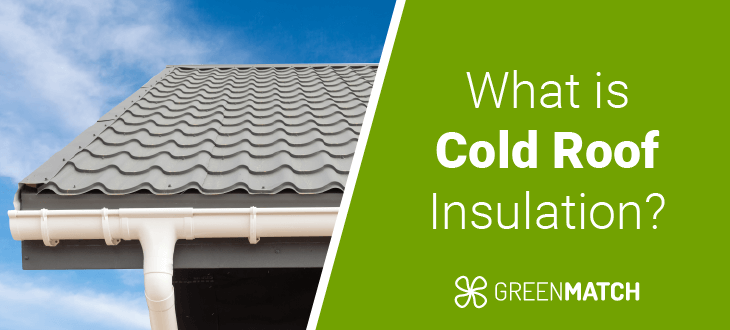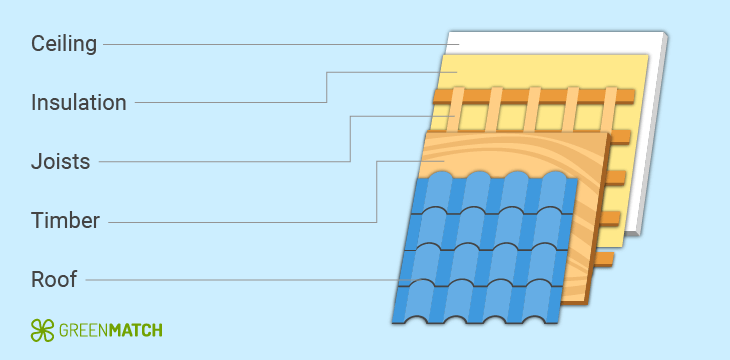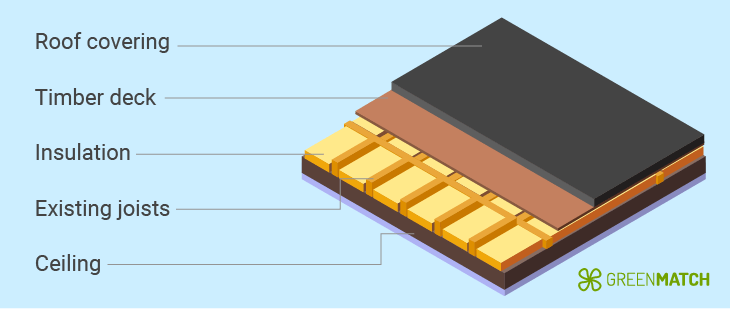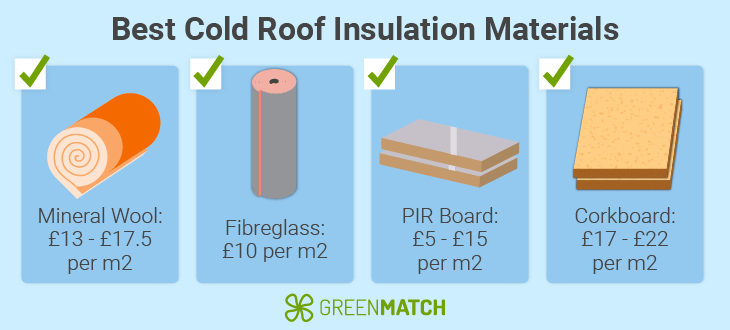Answer these simple questions and we will find you the BEST prices
Which type of solar quotes do you need?
It only takes 30 seconds
100% free with no obligation

Get Free quotes from insulation specialists near you

Save money by comparing quotes and choosing the most competitive offer

The service is 100% free and with no obligation
- GreenMatch
- Insulation
- Roof Insulation
- Cold Roof Insulation
An Ultimate Guide to Cold Roof Insulation


- Cold roof insulation is when insulating material is added between and under the roof rafters, leaving the roof structure uninsulated.
- Cold roof insulation is more affordable than warm roof insulation, costing around £900 for a standard semi-detached UK home.
- Cold roof insulation brings significant savings to your energy bills, cutting your heat loss by more than a quarter and saving you up to £230 every year on energy bills.
Uninsulated roof structures are responsible for over 26% of heat loss experienced in a home. Nearly a quarter of all properties in the UK have uninsulated roofs, leading to strained heating systems, abnormally high carbon emissions, and damp drafty homes.
Luckily, cold roof insulation is an affordable and thermally effective way to boost your home’s heat retention, leading to big savings, less carbon emissions, and a comfortable indoor climate. This ultimate guide by GreenMatch UK will provide all the information you need about cold roof insulation, including the process, best materials, costs, regulations and much more.
Ready to insulate your roof? Let GreenMatch UK free you from the burden of endless research and vetting. By spending just 30 seconds filling out our online form, you can receive up to 3 free home-tailored quotes from our nationwide network of professional installers. No costs or obligations apply. Click the button below to begin!
- Describe your needs
- Get free quotes
- Choose the best offer
It only takes 30 seconds



What is cold roof insulation?
You may be wondering; what is a cold roof? Cold roof insulation is when insulation material is placed between and below the roof rafters, leaving the pitched or flat roof structure uninsulated. Insulating a cold roof will still provide adequate loft insulation but with a lower thermal efficiency when compared to warm roof insulation. Cold roof insulation is best suited for loft spaces that will be used as storage rather than living areas.
Nevertheless, cold roof insulation comes with plenty of benefits. Primarily, it’s more cost-effective than warm roof insulation and requires less labour as all the work can take place from inside the loft, leaving your roof structure unchanged from the outside.
Building regulations roof insulation wise, outline a series of requirements to follow, as set out in Part L of the UK Building Regulations documents. These regulations look at desired u-value, cold roof insulation thickness, and what property changes can take place without a permit.
Cold flat roof insulation

Cold flat roof insulation involves placing insulation material under the structural deck of the roof, as well as adding a waterproof layer to reduce the risk of moisture ingress.
Unlike with warm flat roof insulation between joists, the roof deck remains uninsulated and is exposed to external temperatures, an air gap for ventilation of around 50mm is left between the structural deck and the insulation material to further help avoid moisture buildup.
Cold flat roof insulation between joists is significantly cheaper than a warm flat roof job but is less energy efficient as well. Nevertheless, it’s a drastic improvement for flat roof properties that have no roof insulation in place at all.
Cold pitched roof insulation

Cold pitched roof insulation is when insulation material is fitted in between and under the roof rafters, leaving the roof structure itself uninsulated. This method is a cost-effective way to insulate your roof without the costs and work labour of removing or replacing your roof tiles.
Another key advantage is that cold-pitched roof insulation will still provide some degree of thermal protection for your loft space. Whilst not as efficient as warm-pitched roof insulation, its cost-to-effectiveness ratio makes it a very worthy investment if you are on a lower budget.
In the pitched roof approach, it's also important to remember to add dormer insulation if your roof has a dormer section. That way, you can achieve the best thermal enveloping.
Best cold roof insulation materials

There is no single best roof insulation material for insulating a cold roof, but there are a series of popular insulation materials on the market suited to all types of budgets, performances and conditions. Here’s a rundown of some of the best on the market:
- Mineral wool: Produced as either rock wool or glass wool, these insulators come as blankets or batts with impressive thermal efficiency. Mineral wool tends to cost around £13 - £17.5 per m2 and is relatively sustainable in its production. Mineral wool is also very malleable and useful when insulating irregular shapes and hard-to-reach areas.
- Fibreglass: Similar to mineral wool, fibreglass is produced from recycled glass and costs just around £10 per m2, making it one of the most budget-friendly materials on the market. Found as easy-to-fit blankets and batts, fibreglass is also quite sustainable in production and can be easily recycled.
- PIR board: Made of polyisocyanurate, these synthetic polymer boards pack an impressive thermal efficiency. Costing around £5 – £15 per m2 depending on the thickness, these boards are particularly renowned for their moisture, smoke and flame resistance. The downside is that PIR boards are not very sustainable to produce and are not biodegradable.
- Corkboard: A sustainable alternative to synthetic boards, cork exhibits amazing heat retention qualities and is entirely recyclable. Costing around £17 - £22 per m2, corkboard can be installed in the same way as any other rigid insulation board. The sustainable production, lack of synthetics, and easy recycling of corkboard make it a great sustainable choice for roof insulation.
There may be no single best insulation for cold flat roof jobs, but there's certainly no shortage of materials on the market, even beyond the list we’ve provided. The best choice can be made with the help of a professional installer through a house assessment to help you choose the most effective course of action.
However, finding a professional installer at the right price can be a daunting task, requiring countless hours of research and vetting. Luckily, GreenMatch UK can free you of this burden.
By spending just 30 seconds filling out our online form, you can receive up to 3 free home-tailored quotes straight from our network of trusted installers. Free of charges and obligations. Click below to begin!
- Describe your needs
- Get free quotes
- Choose the best offer
It only takes 30 seconds



How much does cold roof insulation cost?
On average, cold roof insulation for a standard detached UK house costs around £1,100 for a full insulation job. A roof insulation cost can fluctuate depending on your insulation material, outstanding repairs that need addressing, and job complexity amongst other things.
Here’s a breakdown of some insulation material insulation costs per m2, to give you an idea of the price ranges for the most popular roof insulation materials on the market today:
| Insulation material | Cost (£/m2) |
|---|---|
| Mineral wool | £13 - £17.5 |
| Sheep's wool | £17.5 - £22 |
| Fibreglass | £10 |
| PIR board | £5 – £15 |
| PUR board | £5 – £15 |
| Corkboard | £17 - £22 |
| Wood fibre board | £12 - £24 |
Alongside the price of your chosen insulation material, your roof and loft size, installation complexity, and sometimes even location can play a significant role in your final investment.
What are the rules for cold flat roof insulation?
There are several building regulations for roof insulation to ensure that your insulation job is as thermally efficient as it can be, and does not pose a risk to you or your neighbours.
Here’s a rundown of the key regulations you can expect:
- Thermal efficiency: Your cold flat roof insulation must be able to achieve a U-value of 0.25W/m²K to abide by the UK building regulations. A U-value measures the rate of heat transfer that occurs through a material, so a lower U-value means a more thermally efficient material.
- Property structure: Building regulations also outline that the reach of a roof structure cannot be expanded without necessary permits and permissions. These regulations also outline that the density of your roof insulation cannot exceed a certain amount, but this can fluctuate based on several factors and is best to consult a professional.
For a full picture of all the building regulations in place, make sure to consult Part L of the UK Building Regulations document, available online and on the official UK government website.
Warm roof vs cold roof insulation
The main difference between a warm roof and a cold roof insulation job is that warm roof insulation also thermally envelops the entire roof structure, including the rafters and beams. This makes for a much more thermally efficient roof insulation in comparison to a cold roof.
However, homes that intend to use their loft area as a storage space can save money on roof insulation by opting for a cold roof insulation job. While less thermally efficient, cold roof insulation provides adequate thermal enveloping to allow the loft area to be used, whilst still providing a decent degree of temperature regulation.
On the other hand, if you plan to use your loft area as a living space, it’s highly recommended to go ahead with warm roof insulation between joists or rafters. While your initial investment may be higher, the exceptional thermal efficiency will convert your loft into a liveable space, and lead to massive reductions in your energy bills.
Pros and cons of cold roof insulation
All in all, cold roof insulation is a great way to improve your home's thermal performance on a budget, but it’s important to decide how you would like to use your loft space. Here’s a breakdown of the key pros and cons associated with cold roof insulation:
- Cold roof insulation is more budget-friendly than warm roof insulation.
- Cold roof insulation is less labour-intensive and leaves your roof tiles untouched.
- Replacing and topping up cold roof insulation is a simpler process that does not require dismantling of roof portions.
- Cold roof insulation provides less thermal efficiency than warm roof insulation.
- Cold roof insulation does not provide adequate comfort for a loft space to be used for living purposes.
- To enjoy the high energy bill savings, big slashes to your carbon footprint, and a long-term thermally enveloped home, cold roof insulation will not be adequate.
Ready to get cold roof insulation? Great! The next step requires finding the right installer at the right price. The process of landing the best bargain can be tricky though, with most customers stuck in endless hours of researching and vetting. Luckily, GreenMatch UK can free you of this burden.
By spending just 30 seconds filling out our online form, you can receive up to 3 free home-tailored quotes from our network of trusted professional installers. The best part? Our services are free of charges and obligations. Simply click the button below to begin!
- Describe your needs
- Get free quotes
- Choose the best offer
It only takes 30 seconds



FAQ
For a cold roof insulation job, the most popular insulation materials are usually mineral wool and fibreglass. This is because they are budget-friendly and still quite thermally efficient.
A cold roof insulation job requires a vapour barrier and a ventilation gap of at least 50mm to keep the insulation material safe from moisture ingress and mould. A professional installer can make sure to accommodate these needs when carrying out a job.
To convert a cold roof insulation job to a warm roof, insulation material needs to be added over the roof rafters and under the roof tiles, along with a new vapour barrier. This process is a bit more complex and labour-intensive than cold roof insulation.
The main disadvantage of cold roof insulation is that it is not as thermally efficient as warm roof insulation. Granted, it is more budget-friendly, but it will not provide the necessary thermal enveloping that allows your loft to comfortably be used as a living space.
The general regulation for cold flat roof insulation is that it must achieve a U-value of at least 0.25W/m²K to meet the requirements set by UK building regulations. It is also not possible to extend the reach of your roof structure without the necessary permits and permissions in place.

Akif is a copywriter at GreenMatch since 2023. With a keen interest in community sustainability, green solutions and the role of digital media in identifying climate trends, he aims to hone in on his background in International Studies and Digital Media to provide a multidisciplinary approach to written content rooted in credible research and accuracy.
We strive to connect our customers with the right product and supplier. Would you like to be part of GreenMatch?

- An Ultimate Guide to Cold Roof Insulation
- What is cold roof insulation?
- Cold flat roof insulation
- Cold pitched roof insulation
- Best cold roof insulation materials
- How much does cold roof insulation cost?
- What are the rules for cold flat roof insulation?
- Warm roof vs cold roof insulation
- Pros and cons of cold roof insulation
- FAQ
